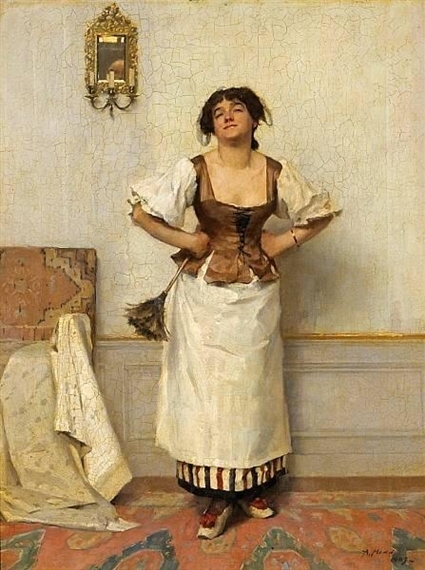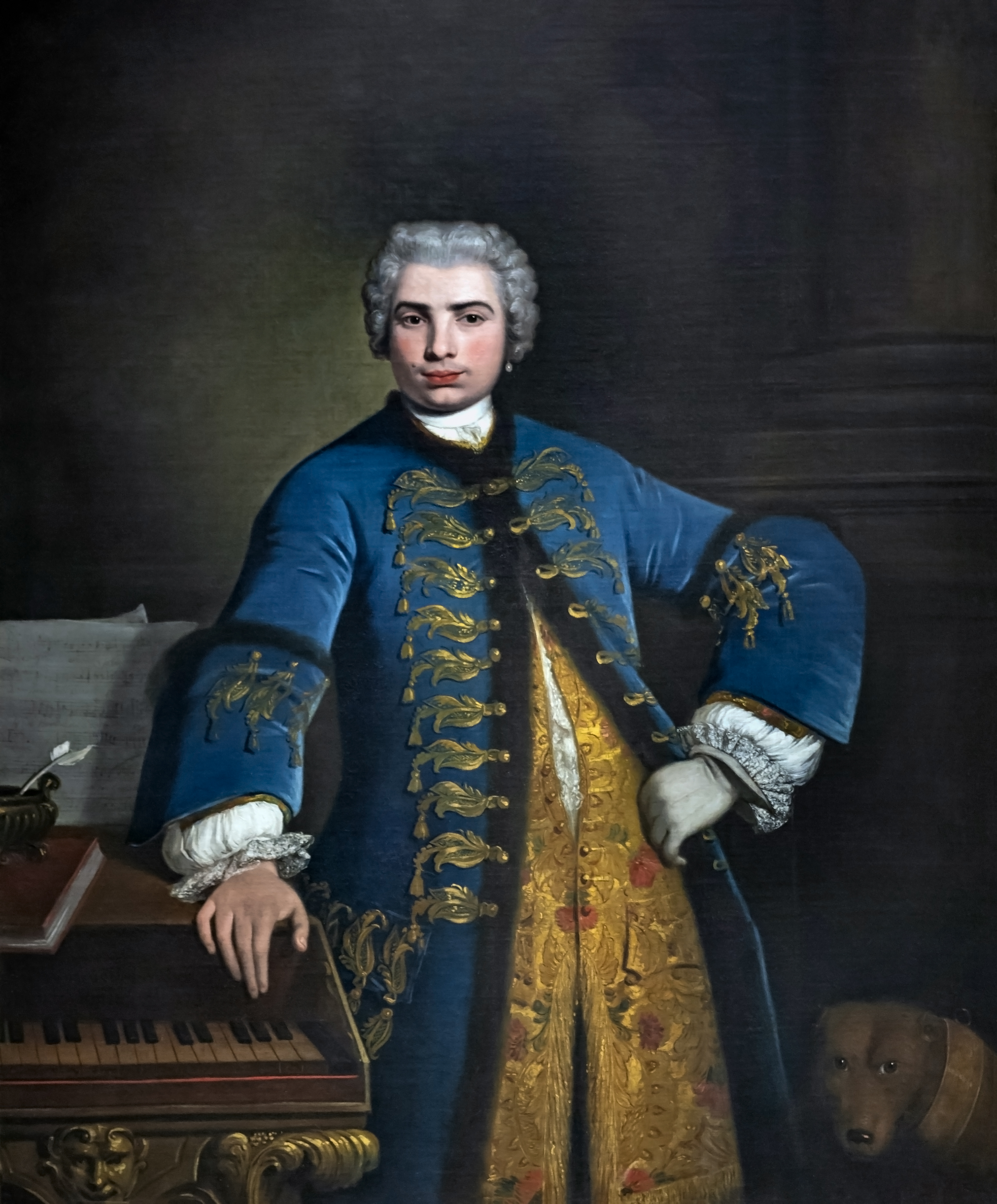|
Soubrette
A soubrette is a female minor stock character in opera and theatre, often a pert lady's maid. By extension, the term can refer generally to any saucy or flirtatious young woman. The term arrived in English from Provençal via French, and means "conceited" or "coy". Theatre In theatre, a soubrette is a comedy character who is vain and girlish, mischievous, lighthearted, coquettish and gossipy—often a chambermaid or confidante of the ingénue. She often displays a flirtatious or even sexually aggressive nature. The soubrette appeared in commedia dell'arte scenarios, often in the role of Columbina, where the actress would provide the details of her behaviour and dialogue. From there, she moved to the works of Molière, which were influenced by the Commedia; the role of Dorine in '' Tartuffe'' (1664) fits the description. A famous example, though a hundred years later, is Suzanne in Beaumarchais' '' Le Mariage de Figaro'' (1784). Opera In classical music and opera, the term ''s ... [...More Info...] [...Related Items...] OR: [Wikipedia] [Google] [Baidu] |
Soprano
A soprano () is a type of classical singing voice and has the highest vocal range of all voice types. The soprano's vocal range (using scientific pitch notation) is from approximately middle C (C4) = 261 Hertz, Hz to A5 in Choir, choral music, or to soprano C (C6) or higher in operatic music. In four-part chorale style harmony, the soprano takes the highest part, which often encompasses the melody. The soprano voice type is generally divided into the coloratura soprano, coloratura, soubrette, lyric soprano, lyric, spinto soprano, spinto, and dramatic soprano, dramatic soprano. Etymology The word "soprano" comes from the Italian word ''wikt:sopra, sopra'' (above, over, on top of),"Soprano" ''Encyclopædia Britannica'' as the soprano is the highest pitch human voice, often given to the leading female roles in operas. "Soprano" refers ... [...More Info...] [...Related Items...] OR: [Wikipedia] [Google] [Baidu] |
Lyric Soprano
A lyric soprano is a type of operatic soprano voice that has a warm quality with a bright, full timbre that can be heard over an orchestra. The lyric soprano voice generally has a higher tessitura than a soubrette and usually plays ingenues and other sympathetic characters in opera. Lyric sopranos have a range from approximately middle C ( C4) to "high D" (D6). This is the most common female singing voice. There is a tendency to divide lyric sopranos into two groups: light and full. Light lyric soprano A light-lyric soprano has a bigger voice than a soubrette but still possesses a youthful quality.Nashville Opera There are a wide variety of roles written for this voice, and they may sing |
Fach
The German system (; literally "compartment" or "subject of study", here in the sense of "vocal specialization") is a method of classifying singers, primarily opera singers, according to the range, weight, and color of their voices. It is used worldwide, but primarily in Europe, especially in German-speaking countries and by repertory opera houses. The ' system is a convenience for singers and opera houses. It prevents singers from being asked to sing roles which they are incapable of performing, or roles for which their vocal timbre is dramatically unsuited. Opera companies keep lists of available singers by ' so that when they are casting roles for an upcoming production, they do not inadvertently contact performers who would be inappropriate for the part. Below is a list of ' (), their ranges as written on sheet music, and roles generally considered appropriate to each. When two names for the ' are given, the first is in more common use today. Where possible, an English and ... [...More Info...] [...Related Items...] OR: [Wikipedia] [Google] [Baidu] |
Voice Type
A voice type is a classification of the human singing voice into perceivable categories or groups. Particular human singing human voice, voices are identified as having certain qualities or characteristics of vocal range, vocal weight, tessitura, vocal timbre, and vocal transition points (''passaggio''), such as breaks and lifts within the voice. Other considerations are physical characteristics, speech level, scientific testing, and vocal register. A singer's voice type is identified by a process known as voice classification, by which the human voice is evaluated and thereby designated into a particular voice type. The discipline of voice classification developed within European classical music and is not generally applicable to other forms of singing. Voice classification is often used within opera to associate possible roles with potential voices. Several different voice classification systems are available to identify voice types, including the German ''Fach'' system and the ... [...More Info...] [...Related Items...] OR: [Wikipedia] [Google] [Baidu] |
Mezzo-soprano
A mezzo-soprano (, ), or mezzo ( ), is a type of classical music, classical female singing human voice, voice whose vocal range lies between the soprano and the contralto voice types. The mezzo-soprano's vocal range usually extends from the A below middle C to the A two octaves above (i.e. A3–A5 in scientific pitch notation, where middle C = C4; 220–880 Hz). In the lower and upper extremes, some mezzo-sopranos may extend down to the F below middle C (F3, 175 Hz) and as high as "high C" (C6, 1047 Hz). The mezzo-soprano voice type is generally divided into the coloratura, lyric, and dramatic. History While mezzo-sopranos typically sing secondary roles in operas, notable exceptions include the title role in Georges Bizet, Bizet's ''Carmen'', Angelina (Cinderella) in Gioachino Rossini, Rossini's ''La Cenerentola'', and Rosina in Rossini's ''The Barber of Seville, Barber of Seville'' (all of which are also sung by sopranos and contraltos). Many 19th-century French- ... [...More Info...] [...Related Items...] OR: [Wikipedia] [Google] [Baidu] |
Coloratura Mezzo-soprano
A mezzo-soprano (, ), or mezzo ( ), is a type of classical female singing voice whose vocal range lies between the soprano and the contralto voice types. The mezzo-soprano's vocal range usually extends from the A below middle C to the A two octaves above (i.e. A3–A5 in scientific pitch notation, where middle C = C4; 220–880 Hz). In the lower and upper extremes, some mezzo-sopranos may extend down to the F below middle C (F3, 175 Hz) and as high as "high C" (C6, 1047 Hz). The mezzo-soprano voice type is generally divided into the coloratura, lyric, and dramatic. History While mezzo-sopranos typically sing secondary roles in operas, notable exceptions include the title role in Bizet's ''Carmen'', Angelina (Cinderella) in Rossini's ''La Cenerentola'', and Rosina in Rossini's '' Barber of Seville'' (all of which are also sung by sopranos and contraltos). Many 19th-century French-language operas give the leading female role to mezzos, including '' Béatrice et B� ... [...More Info...] [...Related Items...] OR: [Wikipedia] [Google] [Baidu] |
Opera
Opera is a form of History of theatre#European theatre, Western theatre in which music is a fundamental component and dramatic roles are taken by Singing, singers. Such a "work" (the literal translation of the Italian word "opera") is typically a collaboration between a composer and a libretto, librettist and incorporates a number of the performing arts, such as acting, Theatrical scenery, scenery, costume, and sometimes dance or ballet. The performance is typically given in an opera house, accompanied by an orchestra or smaller musical ensemble, which since the early 19th century has been led by a conducting, conductor. Although musical theatre is closely related to opera, the two are considered to be distinct from one another. Opera is a key part of Western culture#Music, Western classical music, and Italian tradition in particular. Originally understood as an sung-through, entirely sung piece, in contrast to a play with songs, opera has come to include :Opera genres, numerous ... [...More Info...] [...Related Items...] OR: [Wikipedia] [Google] [Baidu] |
Columbina
Columbine (Italian language, Italian: Colombina; French language, French: Colombine; ) is a stock character in the commedia dell'arte. She is Harlequin's mistress, a comic servant playing the tricky slave type, and wife of Pierrot. Rudlin and Crick use the Italian spelling Colombina in ''Commedia dell'Arte: A Handbook for Troupes''. History The role of the female servant was originally that of an entr'acte dancer. Women were not allowed to be part of the story that was being played out on stage, but they were allowed to have a dance in-between the action. Eventually these women became the buxom and gossipy servants of characters that were already allowed on stage, and then, later, the counterparts to the Zanni characters. Columbine was very down to earth and could always see the situation for what it actually was. She was also sometimes portrayed as a prostitute. She was very infrequently without something to say to or about someone. She is dressed in a very short ragged and pa ... [...More Info...] [...Related Items...] OR: [Wikipedia] [Google] [Baidu] |
Vocal Range
Vocal range is the range of pitches that a human voice can phonate. A common application is within the context of singing, where it is used as a defining characteristic for classifying singing voices into voice types. It is also a topic of study within linguistics, phonetics, and speech-language pathology, particularly in relation to the study of tonal languages and certain types of vocal disorders, although it has little practical application in terms of speech. Singing and the definition of vocal range While the broadest definition of "vocal range" is simply the span from the lowest to the highest note a particular voice can produce, this broad definition is often not what is meant when "vocal range" is discussed in the context of singing. Vocal pedagogists tend to define the vocal range as the total span of "musically useful" pitches that a singer can produce. This is because some of the notes a voice can produce may not be considered usable by the singer within performan ... [...More Info...] [...Related Items...] OR: [Wikipedia] [Google] [Baidu] |
Coloratura
Coloratura ( , , ; , from ''colorata'', the past participle of the verb ''colorare'', 'to color') is a passage of music holding elaboration to a melody. The elaboration usually takes the form of runs, trills, wide leaps or other virtuoso material,''Oxford American Dictionaries''.Apel (1969), p. 184. and the melody is obscured during the passage. The term is mostly applied to vocal music; in instrumental music such passages are called ornamentation. Coloratura is often found in operatic music of the 18th and 19th centuries. Operatic roles in which coloratura plays a large part, and their singers, are also called coloratura.Steane, J. B.; Jander, Owen, "Coloratura" in Sadie (1992) 1: 907. History The term ''coloratura'' was first defined in several early non-Italian music dictionaries: Michael Praetorius's ''Syntagma musicum'' (1618); Sébastien de Brossard's ''Dictionaire de musique'' (1703); and Johann Gottfried Walther's ''Musicalisches Lexicon'' (1732). In these ... [...More Info...] [...Related Items...] OR: [Wikipedia] [Google] [Baidu] |
Lyric Coloratura Soprano
A coloratura soprano () is a type of operatic soprano voice that specializes in music that is distinguished by agile runs, leaps and trills. The term ''coloratura'' refers to the elaborate ornamentation of a melody, which is a typical component of the music written for this voice. Within the coloratura category, there are roles written specifically for lighter voices known as lyric coloraturas and others for larger voices known as dramatic coloraturas. Categories within a certain vocal range are determined by the size, weight and color of the voice. Coloratura is particularly found in vocal music and especially in operatic singing of the 18th and 19th centuries. Lyric coloratura soprano A very agile light voice with a high upper extension, capable of fast vocal coloratura. Lyric coloraturas have a range of approximately middle C ( C4) to "high F" (F6). Such a soprano is sometimes referred to as a soprano leggero if her vocal timbre has a slightly warmer quality. The soprano legge ... [...More Info...] [...Related Items...] OR: [Wikipedia] [Google] [Baidu] |



